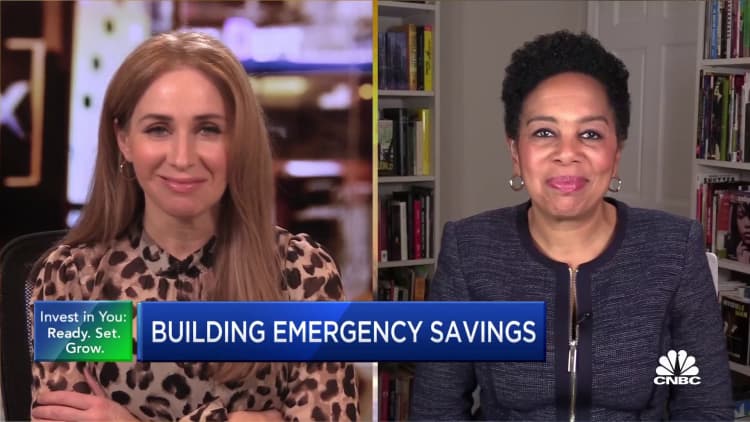It's no secret that households with sufficient emergency savings are more the exception than the norm.
Two proposals in the Senate aim to change that. And, experts say, tackling the problem could lend itself to workers saving more for their golden years.
"One of the best ways to protect retirement savings is to help families more effectively weather short-term emergency savings needs," said Angela Antonelli, executive director of Georgetown University's Center for Retirement Initiatives.
Pandemic showed the need for savings
The Covid-19 pandemic shined a light on the many workers who were unprepared for the financial struggles that ensued from suddenly being without a job and income. While generous government aid aimed to keep families afloat as the economy righted itself, Americans now find themselves battling inflation and rising interest rates that are making both buying and borrowing more expensive.
The overall share of Americans who are either very comfortable (13%) or somewhat comfortable (29%) with their emergency savings dropped to 42% in June from 54% two years ago, according to a recent Bankrate report.
While some companies are offering emergency savings accounts to employees, the Senate proposals come with certain parameters and are both linked to 401(k) plans.

The proposals were approved in separate committees in late June as part of that chamber's evolving version of the so-called Secure Act 2.0. The legislation would build on the original Secure Act of 2019 by making additional changes to the U.S. retirement system in an effort to increase the ranks of savers and the amount they're putting away for their post-working years.
The first proposal being considered would allow companies to automatically enroll their employees in emergency savings accounts, at 3% of pay, that could be accessed at least once a month. Workers would be able to save up to $2,500 in the account, and any excess contributions would automatically go to a linked 401(k) plan account at the company.
The other Senate proposal takes a different approach: It would let workers withdraw up to $1,000 from their 401(k) or individual retirement account to cover emergency expenses without having to pay the typical 10% tax penalty for early withdrawal if they are under age 59½.
More from Personal Finance:
Nearly half of Americans are falling deeper in debt
3 tax breaks that may ease pain of rising college costs
Here's why it's smart to stay invested during volatility
However, a separate account would be the preferable of the two so that people would be less likely to make withdrawals from their 401(k), Antonelli said.
"It helps prevent leakage from retirement savings," she said.
Nevertheless, for workers who have access to a 401(k) or similar workplace plan but don't participate, having emergency funds available could spur them to enroll in their company's retirement plan, said Leigh Phillips, president and CEO of SaverLife, a nonprofit focused on helping households build savings.
"One of the big things that prevents people participating in long-term savings is a lack of short-term liquidity for emergencies," Phillips said.
One of the big things that prevents people participating in long-term savings is a lack of short-term liquidity for emergencies.Leigh PhillipsPresident and CEO of SaverLife
In traditional 401(k) plans, where contributions are made pre-tax, the penalty for withdrawing from an account comes with a 10% tax penalty if the person is under age 59½ (unless they meet an exception allowed by the plan).
"Having money locked away that you can't touch is alarming to some people," Phillips said.
That concern is addressed in state-facilitated retirement programs, which generally auto-enroll workers — those without access to a workplace plan — into Roth IRAs (individuals can opt out of enrollment if they want).
Why Roth accounts can give peace of mind
Roth accounts come with no upfront tax break for contributions as traditional IRAs do, but you generally can reclaim your contributions at any time without an early-withdrawal penalty.
The Roth structure "offers greater flexibility and more conditions that allow someone to tap those savings if they need to," Antonelli said.
Altogether, 46 states have either implemented or considered legislation since 2012 to create retirement savings initiatives to reach workers without a plan at work. More than $476 million is collectively invested through these plans, according to Antonelli's organization.
Although there are some minor differences among the state-run programs, the general idea is that employees are automatically enrolled in a Roth IRA through a payroll deduction (starting around 3% or 5%) unless they opt out.
It's uncertain if either of the Senate's emergency-savings proposals would make it into that chamber's final version of the Secure Act 2.0, or whether an approved provision would look exactly like what's been proposed.
The House passed its version of the Secure Act 2.0 in March. It's uncertain when the Senate may revisit its rendition. Assuming senators give their approval, differences between their legislation and the House bill would need to be worked out before a final version could be fully approved by Congress.
If it doesn't happen this year, the legislative process would start over in a future Congress.


